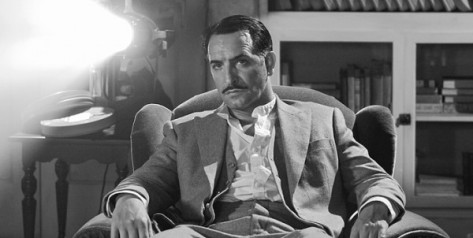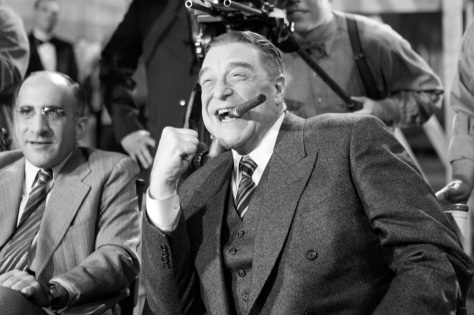NOTE: This review contains spoilers.
Some time last year, I thought to myself, “Why doesn’t anyone make a silent film today? It would be interesting to see a contemporary filmmaker’s take on early cinema.” And then The Artist came along …
I had been looking forward to seeing The Artist since it screened at Cannes mid-last year. The film follows 1927 silent screen superstar George Valentin (Jean Dujardin) as he holds firmly onto his principles at the expense of his career in the wake of the emergence of “talkies.” Following a chance encounter with one of his fans, Peppy Miller (Bérénice Bejo), who bumps into him (literally), she is immediately bitten by the Hollywood bug. As her acting career takes off in the talking pictures, Valentin’s begins to flounder. It’s the stuff A Star Is Born is made of.
Typically, I’m a sucker for movies about movies, and being a classic film buff, I was excited about the prospects of watching a modern-day silent film set in the ’20s, a pivotal period in early cinema. Having just watched it, I can say that it’s a terrific film. As is the case with any great film, all elements come together to make one great picture—a reminder that the sum should always be greater than its parts. The film, much like its leading man Dujardin, is debonair, classy, and charming. The beautiful black-and-white cinematography by Guillaume Schiffman merges with some dazzling performances by Dujardin, Bejo, and John Goodman (who plays a Cecil B. DeMille-type studio executive).
And then there’s the score, which is always a crucial part of any film, but of a silent film in particular, in which it serves as a supporting character when used to its maximum effect. In The Artist, French filmmaker Michel Hazanavicius expertly weaves in Ludovic Bource’s score in an unconventional way to help heighten the impact of the film’s climax. It’s not unusual to use music to emphasize a climax, but it’s traditionally amplified to work in concert with the heightened action. In this movie, Hazanavicius chose to do the opposite—he cuts it completely from the climax. Most “talkies” amplify their scores. This silent film removes it completely, enabling viewers to really focus on the emotion of the scene. By this point in the film, the music is so ingrained in the viewer that its conspicuous absence at this pivotal moment is jarring.
So The Artist is great, but here’s what I didn’t like (SPOILER ALERT!) …
The silent film learns to talk in the very last scene (the denouement, if you will—it’s a French film, so why not throw that word in). In what could be considered a fairly expected move, the resolution includes sound dialogue. Everyone talks. The move feels ill-advised. Hazanavicius works so hard to establish an authentic look and feel (down to the use of a traditional 4:3 aspect ratio), so when the sound makes its appearance, it immediately pulls me out of the world in which I had been lost. If you want to honor silent films, be true to the format. Go silent all the way. Pardon the football reference, but you shouldn’t drop the ball on the 10-yard line. To me, the instance of dialogue at the end is the sound equivalent of Spielberg’s red coat in the for-the-most-part-black-and-white Schindler’s List (1993). Schindler’s List was the first black-and-white film to win Best Picture since Billy Wilder’s The Apartment in 1960.* And now with The Artist as a front-runner to win this year’s Best Picture prize, it may be only the second silent film to earn the honor, after Wings (1927), the very first Best Picture winner.**
—
Rating: 4/5
Director: Michel Hazanavicius
Screenwriter: Michel Hazanavicius
Cast: Jean Dujardin, Bérénice Bejo, John Goodman, James Cromwell
Distributor: The Weinstein Company
Genre: Comedy
Rating: PG-13
Site: weinsteinco.com/theartist
—
*But not really, since the red coat makes the black-and-white in Schindler’s List “untrue.”
**But not really, since the sound dialogue in the final scene makes the “silence” in The Artist “untrue.”
[youtube http://www.youtube.com/watch?v=OK7pfLlsUQM]



Wow, this movie sounds super interesting. I totally didn’t care too much for it when I first heard about it, but I’m definitely going to give it another look! Thanks! 🙂
LikeLike
I mostly agree (my review at http://grassrootsmovement.wordpress.com/2011/12/24/movie-review-the-artist/ ), but I hadn’t really seen many take issue with the speaking at the end, so I’m glad to see I’m not alone! I realize they felt the need to explain why our hero couldn’t ‘just get with the times,’ conform, and get work in talkies, but I think the mystery would have been better than spoiling the entire ‘silent’ artifice when they had made it 146 minutes without a spoken word.
LikeLike
Thanks for the thoughtful comment. I’ll take a look at your review. 🙂
LikeLike
I can’t wait to see this, but it isn’t playing near me. I’ll have to come back and read the spoiler parts after I see the movie.
LikeLike
I’m glad my spoiler alert worked! 🙂
LikeLike